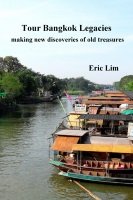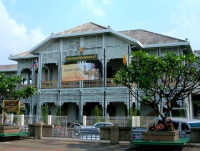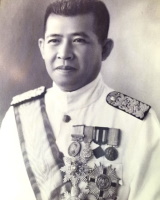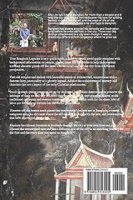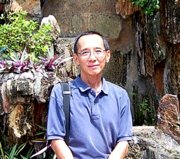- Home
- Democracy Monument
- Phibun Songkhram
Phibun Songkhram
the master of the coup d'etat
By Eric Lim
Phibun Songkhram was one of the 114 members of the Promoters, the group that launched the coup on 24 June 1932 that changed the government to a constitutional monarchy.
Born Plaek Khittasangkha in 1897 to a humble family in Nonthaburi province just north of Bangkok, he joined the military academy at 12, graduated at 17 and joined the artillery.
His outstanding military performance was rewarded with advanced training in France from 1924 – 1927.
It was in France, where the seeds of discontent against the absolute monarchy were fermenting among the young Thai students, that he met Pridi Banomyong a young law student.
The two of them would be instrumental in the 1932 coup.
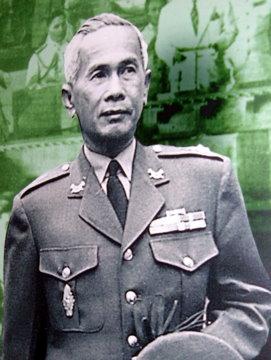
Field Marshal Phibun Songkhram –
courtesy of the Museum of Nonthaburi
In 1928 a year after his return to Bangkok, he was granted the rank and title Luang Phibunsongkhram which he adopted as his family name. He became known to the rest of the world as Phibun Songkhram.
In his political career spanning 25 years, Phibun Songkhram was responsible for four coups, put down a rebellion, was Prime Minister for two terms, totaling 14 years, survived three coups while in power and was finally overthrown in a coup.
Love him or hate him, he left his mark in Thai political history.
Barely a year after the first coup in 1932, Phibun struck again. When conservatives in the new government tried to curb the powers of the junior military faction, Phibun staged a coup on 20 June 1933 and installed his backer Phraya Phahon as Prime Minister.
During a rebellion of royalist troops against the government in October 1933, it was Lieutenant-Colonel Phibun who commanded the government troops that crushed the rebellion after three days of intense fighting.
When Phraya Phahon was forced to resign after a scandal, Field Marshall Phibun became the Prime Minister in 1938. He imposed a military dictatorship, arrested members of the royal family, members of the opposition and his rivals.
In 1939 he changed the country's name Siam to Thailand and embarked on a campaign of fervent nationalism. It was Thailand for the Thais.
Part of this campaign was a spate of anti-Chinese policies to curb ethnic Chinese dominance of the economy, restrict Chinese education, newspapers and culture.
During his first term as prime minister (1938 – 1944), Phibun Songkhram issued several decrees.
- Thais were told to wear Western dress; coat, trousers, shirt and tie for men; skirts, blouses, hats and gloves for women; and all in shoes.
- New Year’s Day was changed from April, the traditional date to 1 January. However, Thais took the practical approach and celebrate on both dates.
- Another of his decrees was to encourage Thai men to kiss their wives goodbye, in the mornings when they leave for work, that is.
In 1940 when France fell to Germany, Phibun grabbed the opportunity to recover the territories lost to France in 1893.
Whipping up nationalistic fervor he occupied the disputed territories in French Indo-China, in a war that lasted from November 1940 - January 1941.
After the ceasefire mediated by Japan, the provinces of Batambang and Siem Reap in what is now Cambodia were ceded to Thailand and renamed Phibun Songkhram province.
In memory of those who died in this war, Phibun erected the Victory Monument in Bangkok.
During World War II, Phibun Songkhram made the controversial decision to collaborate with Japan and declare war on the Allies.
As the Japanese were already on Thai soil, the decision probably saved Thailand from the ravages of war. That decision and his pro-Fascist leanings alienated him from the West.
When it was clear that Japan was losing the war, Phibun was dumped in favor of the civilian, Khuang Apaiwong on 31 July 1944.
On 8 Nov 1947, when the post WW II government was paralysed by factional infighting and defections, Phibun staged another coup and took over the government. Stained by his wartime association with Japan, Phibun Songkhram remained in the background.
To win acceptance by the West, Khuang was appointed PM once again. Phibun bided his time and on 08 April 1948, Khuang Apaiwong, the man who replaced Phibun four years ago, was forced out from office. Phibun Songkhram became Prime Minister for the second time.
In his second term of office from 1948 – 1957, Phibun was to display his political pragmatism again.
This time he cooperated closely with the USA in their Cold War efforts to contain the communist threat in Indo-China.
As a result Thailand not only regained its credibility with the West, it benefited from the American aid that poured in. The military and police arsenals grew rapidly and so did their bank accounts.
Phibun's second term however was fraught with unrest. He survived three coups; an abortive coup in 1948, a revolt in 1949 that was crushed; and an open war in 1951, when he was abducted.
That didn't stop him was launching a coup of his own. On 29 November 1951, in an unusual coup, known as the Radio Coup, the military took over a radio station and announced the suspension of the 1949 constitution and reinstated the 1932 constitution in a bid to consolidate their power.
On 16 September 1957, the man who has lived by the coup was finally overthrown by Field Marshall Sarit Thanarat, his former ally and the army chief then.
Phibun, like Pridi before him, had to flee his country.
This was not to be the last time an army chief ousted his political master. In September 2006, General Sonthi Boonyakalin, the army chief overthrew Premier Taksin Shinawatra.
For more on the coups, please see Coups in
Bangkok.
There's a road in the outskirts of Bangkok leading to the province of Nonthaburi named after Phibun Songkhram.
Ironically, the road is barely 300 m from the King
Rama VII Bridge, named after King Prajadhipok whom Phibun launched the coup
against in 1932 – the coup that changed the course of Thai
history.
Phibun is listed on the Wall of Fame in the Museum of
Nonthaburi a museum preserving the history of the province where he was
born.
To return to the Democracy Monument.
Related Pages
Tour Bangkok Legacies – my first e-book
If you are an independent traveller, here's a handy e-guide book, Tour Bangkok Legacies, which will help you along as you explore the streets of Bangkok and discover its old treasures. It's complete with historical descriptions, maps and detailed directions on how to get to these places.
My Kindle e-book
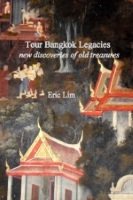
Tour Bangkok Legacies - Kindle paperback edition
For those who prefer reading printed books rather than e-books, here's the paperback edition of Tour Bangkok Legacies, which will help you along as you explore the streets of Bangkok and discover its old treasures. It's complete with historical descriptions and directions on how to get to these places.
My Kindle paperback edition
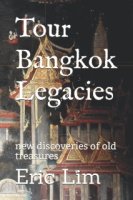
Search Tour Bangkok Legacies with DuckDuckGo
Related pages
My Journey through Thailand
Part I The First Steps
My Kindle edition
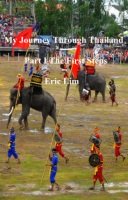
My Smashwords edition
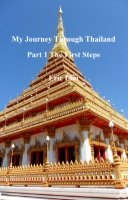
Tour Bangkok Legacies
new discoveries of old treasures
My Kindle edition

My Smashwords edition
